

TO MASTER THE ART |
||
|
William Brown |
written by William Brown |
Andrew Hansen |
|
Marilyn Langbehn |
||
|
Cast (in alphabetical order) |
||
|
Laszlo Horner |
|
|
Follow Us:
Cast
Creative Team
William Brown
Doug Frew
Andrew Hansen
Marilyn Langbehn
Courtney Carson
Madeline Berger
Sam Fehr
Daniel "Techno" Debono
Devon LaBelle
Calli Caraval
Erin Merritt
Kristin Smith
Zoe Whitaker
Isaiah Johnson
Ralph Hoy
Lynda Hornada
Meet the Company
Maria Mikheyenko
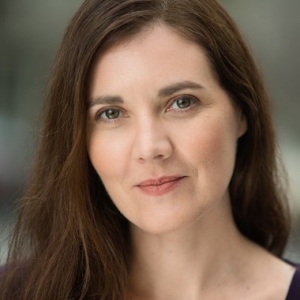 MARIA MIKHEYENKO is thrilled to return to CCCT after playing Mother in Ragtime. Stage credits: Helen (u/s) in Fun Home, Mother in A Christmas Story (Berkeley Playhouse), Old Shady in Men On Boats (Palo Alto Players), Miss Casewell in The Mousetrap (Ross Valley Players), Mrs. Cratchit in Scrooge in Love! (42nd Street Moon), Dorothy Brock in 42nd Street (Pacific Coast Repertory Theatre), Alaura Kingsley in City of Angels (Cinnabar Theater), Mrs. Nordstrom in A Little Night Music (Hillbarn Theatre), Berlin to Broadway with Kurt Weill (Masquers Playhouse). Maria has performed with Pacific Edge Voices in collaboration with Bobby McFerrin, Meredith Monk, and Dave Brubeck, and is a voice-over artist and composer for PuppetART Detroit Puppet Theatre. Bon appétit! www.MariaMikheyenko.com
MARIA MIKHEYENKO is thrilled to return to CCCT after playing Mother in Ragtime. Stage credits: Helen (u/s) in Fun Home, Mother in A Christmas Story (Berkeley Playhouse), Old Shady in Men On Boats (Palo Alto Players), Miss Casewell in The Mousetrap (Ross Valley Players), Mrs. Cratchit in Scrooge in Love! (42nd Street Moon), Dorothy Brock in 42nd Street (Pacific Coast Repertory Theatre), Alaura Kingsley in City of Angels (Cinnabar Theater), Mrs. Nordstrom in A Little Night Music (Hillbarn Theatre), Berlin to Broadway with Kurt Weill (Masquers Playhouse). Maria has performed with Pacific Edge Voices in collaboration with Bobby McFerrin, Meredith Monk, and Dave Brubeck, and is a voice-over artist and composer for PuppetART Detroit Puppet Theatre. Bon appétit! www.MariaMikheyenko.com
Michael Sally
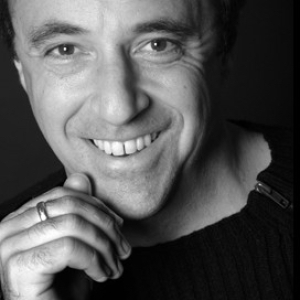 MICHAEL SALLY Director: 42nd Street (Stage One), Born Yesterday, Wait Until Dark, Arsenic and Old Lace, Lost in Yonkers (Chanticleers), The First Supper (Altarena), The Odd Couple (Hillbarn), The Laramie Project and Expecting Isabel (Masquer’s Playhouse). Actor: The Moon for the Misbegotten (Eugene O’Neill Festival), American Buffalo (Vallejo Stage), Oslo, Middletown (Los Altos Stage), All the Way, (CCCT), Woman in Mind (Town Hall Theatre), Once Upon a Mattress, Hello, Dolly!, It’s a Wonderful Life Radio Show,(Douglas Morrison) Bullets Over Broadway (TriValley Rep), 1776 (Contra Costa Musical Theatre), Glengary Glen Ross (Altarena), The Farnsworth Invention (Palo Alto Players), God of Carnage (Piedmont Players). Other appearances include Requiem for a Heavyweight, Ah, Wilderness!, The Lisbon Traviata, Distracted!, Lips Together, Teeth Apart, Scrooge!, Blithe Spirit, Sylvia, 25th Annual Putnam County Spelling Bee, Moonlight and Magnolias, The Underpants, The Little Foxes, The Foreigner. Playwright: Just My TYPE, based on the work of Myers-Briggs (which had its World Premiere at Ross Valley Players in 2018), and solo shows Parental Guidance Suggested, Confessions of a NuJu and I am not Done Yet. He is also the Managing Director of Masquers Playhouse in Pt Richmond.
MICHAEL SALLY Director: 42nd Street (Stage One), Born Yesterday, Wait Until Dark, Arsenic and Old Lace, Lost in Yonkers (Chanticleers), The First Supper (Altarena), The Odd Couple (Hillbarn), The Laramie Project and Expecting Isabel (Masquer’s Playhouse). Actor: The Moon for the Misbegotten (Eugene O’Neill Festival), American Buffalo (Vallejo Stage), Oslo, Middletown (Los Altos Stage), All the Way, (CCCT), Woman in Mind (Town Hall Theatre), Once Upon a Mattress, Hello, Dolly!, It’s a Wonderful Life Radio Show,(Douglas Morrison) Bullets Over Broadway (TriValley Rep), 1776 (Contra Costa Musical Theatre), Glengary Glen Ross (Altarena), The Farnsworth Invention (Palo Alto Players), God of Carnage (Piedmont Players). Other appearances include Requiem for a Heavyweight, Ah, Wilderness!, The Lisbon Traviata, Distracted!, Lips Together, Teeth Apart, Scrooge!, Blithe Spirit, Sylvia, 25th Annual Putnam County Spelling Bee, Moonlight and Magnolias, The Underpants, The Little Foxes, The Foreigner. Playwright: Just My TYPE, based on the work of Myers-Briggs (which had its World Premiere at Ross Valley Players in 2018), and solo shows Parental Guidance Suggested, Confessions of a NuJu and I am not Done Yet. He is also the Managing Director of Masquers Playhouse in Pt Richmond.
Harrison Alter
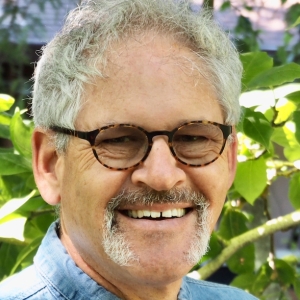 After a 35-year detour as a physician, most of which he spent working and teaching in the emergency department at Highland Hospital in Oakland, CA, HARRISON ALTER is so pleased to be rediscovering the passion for theater that carried him through high school and college, where roles included Tevye in Fiddler on the Roof and Emile DeBecque in South Pacific. In addition to Bay Area emergency medicine, Harrison has also worked as a doctor for the Navajo Nation, and for Alameda County Health Care for the Homeless. Harrison was born and raised in Chicago, and has an undergraduate degree in Comparative Literature from Brown University, a Master’s from The University of California, and a Doctorate from UCSF. He lives in Berkeley with (some of) his family, to whom he is so grateful for their support and encouragement.
After a 35-year detour as a physician, most of which he spent working and teaching in the emergency department at Highland Hospital in Oakland, CA, HARRISON ALTER is so pleased to be rediscovering the passion for theater that carried him through high school and college, where roles included Tevye in Fiddler on the Roof and Emile DeBecque in South Pacific. In addition to Bay Area emergency medicine, Harrison has also worked as a doctor for the Navajo Nation, and for Alameda County Health Care for the Homeless. Harrison was born and raised in Chicago, and has an undergraduate degree in Comparative Literature from Brown University, a Master’s from The University of California, and a Doctorate from UCSF. He lives in Berkeley with (some of) his family, to whom he is so grateful for their support and encouragement.
Anne Yumi Kobori
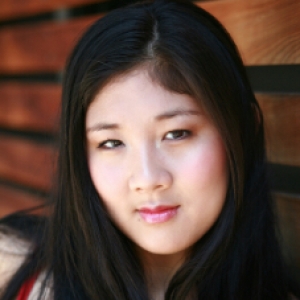 ANNE YUMI KOBORI is a Japanese-American actor, playwright, director, producer, and teaching artist. Select performance credits: title role in Hamlet (Silicon Valley Shakespeare), Celia in As You Like It the musical (SF Shakespeare), Henrietta in The Hollow (City Lights Theater), Peggy Maruyama in Allegiance (CCCT), Irene in Nevermind (Kunoichi Productions), and Masha in Three Sisters immersive (Utopia Theatre Project). Recent writing projects include Braided at Cal Shakes, A.C.T.’s Neo Symposium, The Window Affair with PlayGround Festival, Wish and Rue (MondayNightPlayGround), Roses in the Desert (Dragon Theatre), and the Pear Slices festival with Pear Theatre, where she is a Playwrights’ Guild member. Anne is currently writing Apertures of Love in Times of War with the PlayGround Playwrights Residency Program. www.anneyumikobori.com
ANNE YUMI KOBORI is a Japanese-American actor, playwright, director, producer, and teaching artist. Select performance credits: title role in Hamlet (Silicon Valley Shakespeare), Celia in As You Like It the musical (SF Shakespeare), Henrietta in The Hollow (City Lights Theater), Peggy Maruyama in Allegiance (CCCT), Irene in Nevermind (Kunoichi Productions), and Masha in Three Sisters immersive (Utopia Theatre Project). Recent writing projects include Braided at Cal Shakes, A.C.T.’s Neo Symposium, The Window Affair with PlayGround Festival, Wish and Rue (MondayNightPlayGround), Roses in the Desert (Dragon Theatre), and the Pear Slices festival with Pear Theatre, where she is a Playwrights’ Guild member. Anne is currently writing Apertures of Love in Times of War with the PlayGround Playwrights Residency Program. www.anneyumikobori.com
Trish Tillman
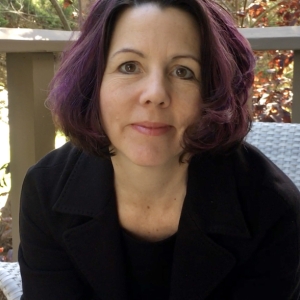 TRISH TILLMAN has been an actor, improvisor, and theater arts teacher in the Bay Area and New York for 25 years. She was last seen on the CCCT stage as Casey/Olga in Anton in Show Business, and as Jessie in The Complete Works of William Shakespeare (Abridged) for which she was nominated for a TBA Award for Outstanding Performance. In addition to acting, she has taught acting and improvisation programs for all ages at A.C.T. (American Conservatory Theater), California Shakespeare Theater, Brandeis Marin School, the ARC of San Francisco, and many others. She is so happy to be here again with such a great cast and crew!
TRISH TILLMAN has been an actor, improvisor, and theater arts teacher in the Bay Area and New York for 25 years. She was last seen on the CCCT stage as Casey/Olga in Anton in Show Business, and as Jessie in The Complete Works of William Shakespeare (Abridged) for which she was nominated for a TBA Award for Outstanding Performance. In addition to acting, she has taught acting and improvisation programs for all ages at A.C.T. (American Conservatory Theater), California Shakespeare Theater, Brandeis Marin School, the ARC of San Francisco, and many others. She is so happy to be here again with such a great cast and crew!
Kelly Rinehart
 KELLY RINEHART is thrilled to be back at CCCT after being part of their return to live theatre with Our Town last fall. She was most recently seen as Frankie in Frankie and Johnny in the Claire de Lune at the Pear, playing opposite her husband, and as Julia Budder in Altarena’s production of It’s Only A Play. She has worked with Dragon, Custom Made Theatre Company, Hillbarn, Palo Alto Players, Ragged Wing, SF Olympians Festival, and Those Women Productions, among others. Her day jobs include being an augmentative alternative communication (AAC) specialist and a teaching artist doing improv with youth in long-term hospital stays. She enjoys cooking but has not yet made any recipes from Julia’s book. She hopes to rectify that after this show closes.
KELLY RINEHART is thrilled to be back at CCCT after being part of their return to live theatre with Our Town last fall. She was most recently seen as Frankie in Frankie and Johnny in the Claire de Lune at the Pear, playing opposite her husband, and as Julia Budder in Altarena’s production of It’s Only A Play. She has worked with Dragon, Custom Made Theatre Company, Hillbarn, Palo Alto Players, Ragged Wing, SF Olympians Festival, and Those Women Productions, among others. Her day jobs include being an augmentative alternative communication (AAC) specialist and a teaching artist doing improv with youth in long-term hospital stays. She enjoys cooking but has not yet made any recipes from Julia’s book. She hopes to rectify that after this show closes.
Jeremy Cole
 JEREMY COLE is returning for his third show at CCCT, after directing Great Expectations and appearing in All the Way as Walter Jenkins, LBJ’s right-hand man. He is currently workshopping the play Fordlandia, written by his friend Coleen Hubbard, which focuses on Henry Ford’s ill-fated rubber plantation in the heart of the Amazon. Jeremy thanks Marilyn for casting him and getting him out of his home/office. When he’s not doing theater, Jeremy reads. A lot.
JEREMY COLE is returning for his third show at CCCT, after directing Great Expectations and appearing in All the Way as Walter Jenkins, LBJ’s right-hand man. He is currently workshopping the play Fordlandia, written by his friend Coleen Hubbard, which focuses on Henry Ford’s ill-fated rubber plantation in the heart of the Amazon. Jeremy thanks Marilyn for casting him and getting him out of his home/office. When he’s not doing theater, Jeremy reads. A lot.
Laszlo Horner
 CCCT habitués will recall LASZLO HORNER‘s exploits as sundry soldiers (and a Pope) in All Is Calm and as Robert S. McNamara in All the Way. More recently, he appeared in Altarena Playhouse’s production of Come Back, Little Sheba. He has also been featured in several staged readings with Actors Ensemble of Berkeley and with the Ross Valley Players’ RAW program. He is delighted to emerge from COVID hibernation to return home to CCCT.
CCCT habitués will recall LASZLO HORNER‘s exploits as sundry soldiers (and a Pope) in All Is Calm and as Robert S. McNamara in All the Way. More recently, he appeared in Altarena Playhouse’s production of Come Back, Little Sheba. He has also been featured in several staged readings with Actors Ensemble of Berkeley and with the Ross Valley Players’ RAW program. He is delighted to emerge from COVID hibernation to return home to CCCT.
William Brown
Doug Frew
Andrew Hansen
Marilyn Langbehn
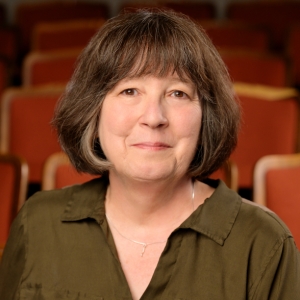 MARILYN LANGBEHN (director) is in her tenth season at CCCT. Productions for the company include Anton in Show Business, Our Town, The Last Five Years, Broadway Inside Out, Bright Star, All the Way, Ragtime, All is Calm: The Christmas Truce of 1914, Cabaret, The Sound of Music, The Complete Works of William Shakespeare (abridged)[revised], The Mountaintop, and the world premiere of The Lost Years. Her critically-acclaimed production of August: Osage County received Best Production and Best Director nods at the inaugural TBA Awards in 2014. She founded the Theatre’s Reading Stage series in 2015 to showcase the work of women playwrights and playwrights of color. To date, the series has produced more than 20 works, including plays by Katori Hall, Theresa Rebeck, Cynthia Wands, kimber lee, Leah Nanako Winkler, Jiréh Breon Holder, and Inda Craig-Galván, and the widely-acclaimed world premiere of her play, Running For My Life.
MARILYN LANGBEHN (director) is in her tenth season at CCCT. Productions for the company include Anton in Show Business, Our Town, The Last Five Years, Broadway Inside Out, Bright Star, All the Way, Ragtime, All is Calm: The Christmas Truce of 1914, Cabaret, The Sound of Music, The Complete Works of William Shakespeare (abridged)[revised], The Mountaintop, and the world premiere of The Lost Years. Her critically-acclaimed production of August: Osage County received Best Production and Best Director nods at the inaugural TBA Awards in 2014. She founded the Theatre’s Reading Stage series in 2015 to showcase the work of women playwrights and playwrights of color. To date, the series has produced more than 20 works, including plays by Katori Hall, Theresa Rebeck, Cynthia Wands, kimber lee, Leah Nanako Winkler, Jiréh Breon Holder, and Inda Craig-Galván, and the widely-acclaimed world premiere of her play, Running For My Life.
Courtney Carson
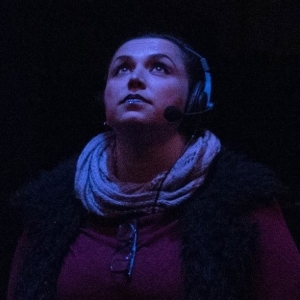 Courtney has been working backstage for over 20 years, with entirely too many credits to list. Career highlights: Working Blue Man Group's tour, bowing on stage with them nightly; winning three Four Star Theatre Awards in one night for Outstanding Set Design, Outstanding Overall Production, and Outstanding Lighting Design; and rigging a Barbie doll to fly across a theatre as Tinkerbell with ten-year-old stagehands. As always, many thanks to James for dealing with my brand of crazy and helping me when I need an adult; Mombie for always encouraging my theatrical endeavors; and to Bob Decker, my high school drama teacher, who saw something in me and opened up the stage curtains to the magic of theatre to me 25 years ago—you truly taught me to find my light and stand with purpose.
Courtney has been working backstage for over 20 years, with entirely too many credits to list. Career highlights: Working Blue Man Group's tour, bowing on stage with them nightly; winning three Four Star Theatre Awards in one night for Outstanding Set Design, Outstanding Overall Production, and Outstanding Lighting Design; and rigging a Barbie doll to fly across a theatre as Tinkerbell with ten-year-old stagehands. As always, many thanks to James for dealing with my brand of crazy and helping me when I need an adult; Mombie for always encouraging my theatrical endeavors; and to Bob Decker, my high school drama teacher, who saw something in me and opened up the stage curtains to the magic of theatre to me 25 years ago—you truly taught me to find my light and stand with purpose.
Madeline Berger
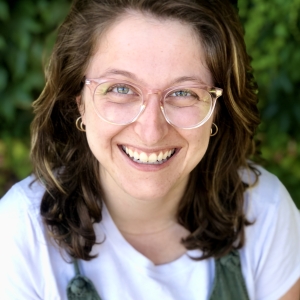 Madeline is a talented and multifaceted costume designer and wardrobe stylist based in the Bay Area. With her background as a Local 784 costumer, tailor, and professor of Costume Design, she brings a wealth of knowledge and experience to every project she works on. Madeline is known for her exceptional organizational skills, her ability to manage people and projects with ease, and her meticulous attention to detail. She is a strong communicator and welcomes constructive criticism, making her an invaluable asset to any team.
With a passion for creating costumes that serve a purpose beyond her own artistic vision, Madeline has brought together a talented group of individuals to form the Bay Area's first full-service costume design house. This innovative company provides a platform for costume design to flourish as an art form and makes the world of wardrobe more accessible to all. Madeline's leadership and commitment to her craft have made her an integral part of the Bay Area's creative community.
Madeline is a talented and multifaceted costume designer and wardrobe stylist based in the Bay Area. With her background as a Local 784 costumer, tailor, and professor of Costume Design, she brings a wealth of knowledge and experience to every project she works on. Madeline is known for her exceptional organizational skills, her ability to manage people and projects with ease, and her meticulous attention to detail. She is a strong communicator and welcomes constructive criticism, making her an invaluable asset to any team.
With a passion for creating costumes that serve a purpose beyond her own artistic vision, Madeline has brought together a talented group of individuals to form the Bay Area's first full-service costume design house. This innovative company provides a platform for costume design to flourish as an art form and makes the world of wardrobe more accessible to all. Madeline's leadership and commitment to her craft have made her an integral part of the Bay Area's creative community.
Sam Fehr
Daniel "Techno" Debono
 Techno is thrilled to be back for another production at Contra Costa Civic Theatre! Their past design credits at CCCT include Our Town (2021), Anton in Show Business (2022), Crowns (2022), and Camelot (2022). Techno has been designing and mixing Theatrical Sound in the SF Bay Area since 2010, initially training under Jack Morocco (Contra Costa College, Pyrotechniques, Mythbusters) for more than six years. Techno would like to especially thank their wife, Maia for the long discussions of her time living in Paris, their shared passion for cooking, and the constant above and beyond support which makes any of this possible. When not in theaters, Techno enjoys competitive graphic design, fiber arts, and writing their own bios in the third person.
Techno is thrilled to be back for another production at Contra Costa Civic Theatre! Their past design credits at CCCT include Our Town (2021), Anton in Show Business (2022), Crowns (2022), and Camelot (2022). Techno has been designing and mixing Theatrical Sound in the SF Bay Area since 2010, initially training under Jack Morocco (Contra Costa College, Pyrotechniques, Mythbusters) for more than six years. Techno would like to especially thank their wife, Maia for the long discussions of her time living in Paris, their shared passion for cooking, and the constant above and beyond support which makes any of this possible. When not in theaters, Techno enjoys competitive graphic design, fiber arts, and writing their own bios in the third person.
Devon LaBelle
 Devon is happy to help. She’s been making props in the Bay Area since 2008. Devon is the Prop Shop Coordinator at SFSU, a company member with Shotgun Players, and a Resident Artist with Crowded Fire Theatre.
To Master the Art marks her ninth season making props for CCCT.
Devon is happy to help. She’s been making props in the Bay Area since 2008. Devon is the Prop Shop Coordinator at SFSU, a company member with Shotgun Players, and a Resident Artist with Crowded Fire Theatre.
To Master the Art marks her ninth season making props for CCCT.
Calli Caraval
Erin Merritt
Kristin Smith
Zoe Whitaker
 Zoe Whitaker (she/her) is thrilled to be stage managing at CCCT! She's previously stage managed at Masquers for their night of British comedy, Keep Calm and Laugh On, that was directed by Angela Mason. Aside from stage managing, she is currently studying at Diablo Valley College and is on track to getting her associates degree in acting. Her last acting performance was The Addams Family, at DVC. Zoe is thankful for the opportunity to stage manage this wonderful show. She hopes you enjoy the show!
Zoe Whitaker (she/her) is thrilled to be stage managing at CCCT! She's previously stage managed at Masquers for their night of British comedy, Keep Calm and Laugh On, that was directed by Angela Mason. Aside from stage managing, she is currently studying at Diablo Valley College and is on track to getting her associates degree in acting. Her last acting performance was The Addams Family, at DVC. Zoe is thankful for the opportunity to stage manage this wonderful show. She hopes you enjoy the show!
Isaiah Johnson
Ralph Hoy
Lynda Hornada
Photos
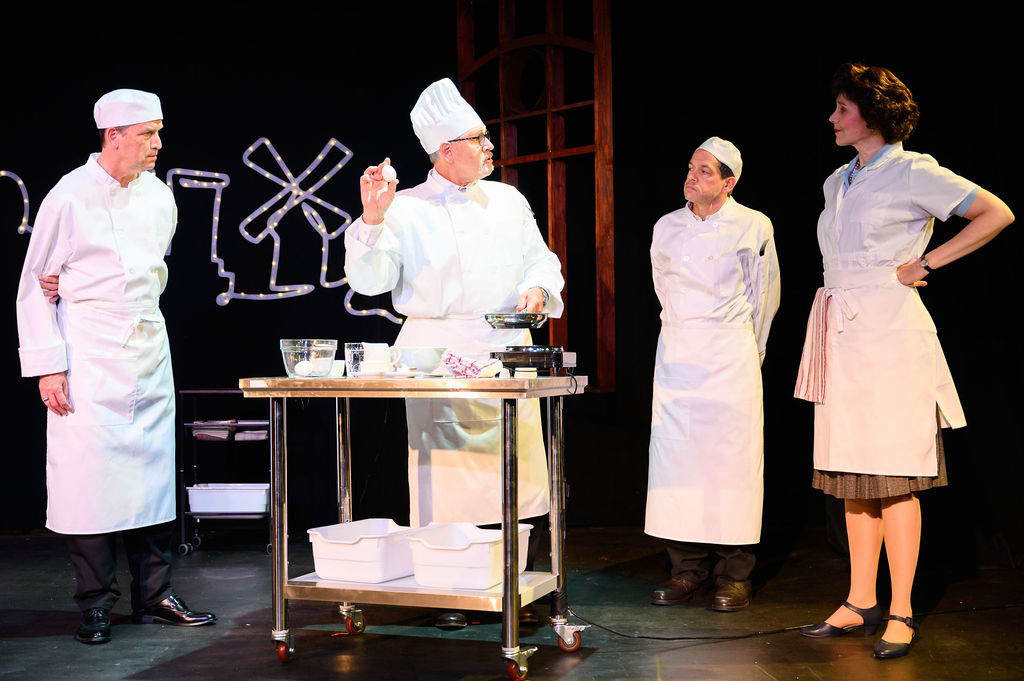
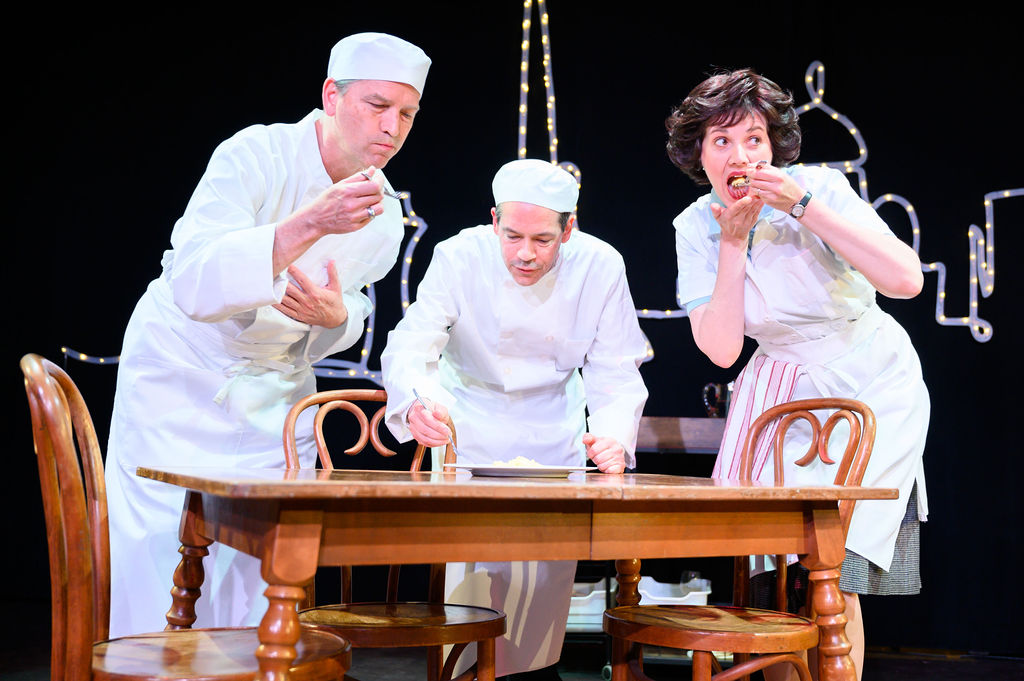
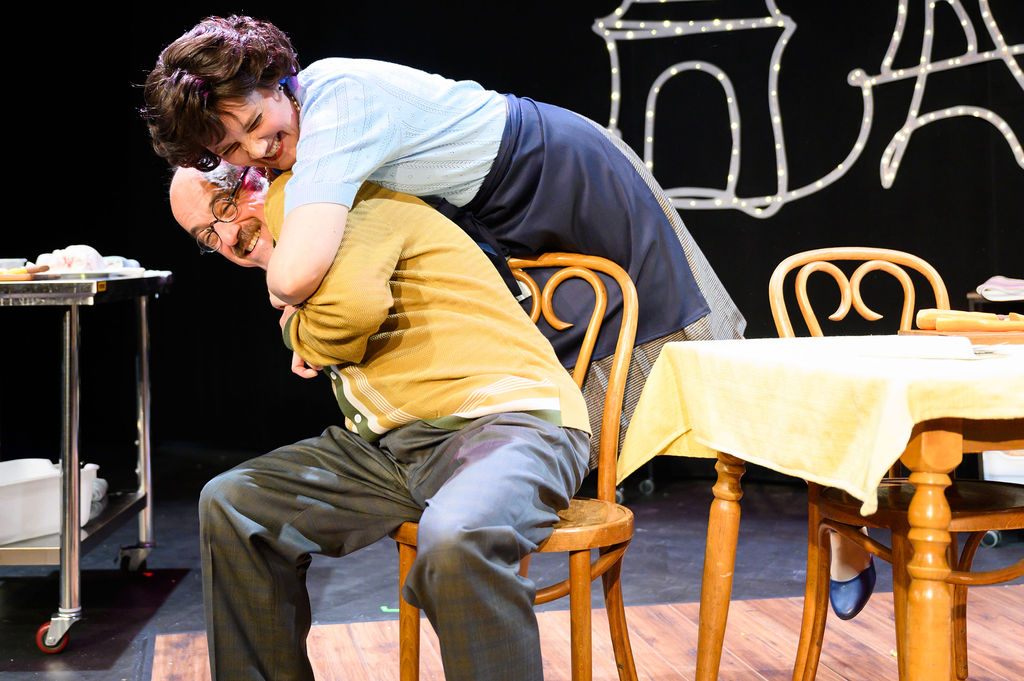
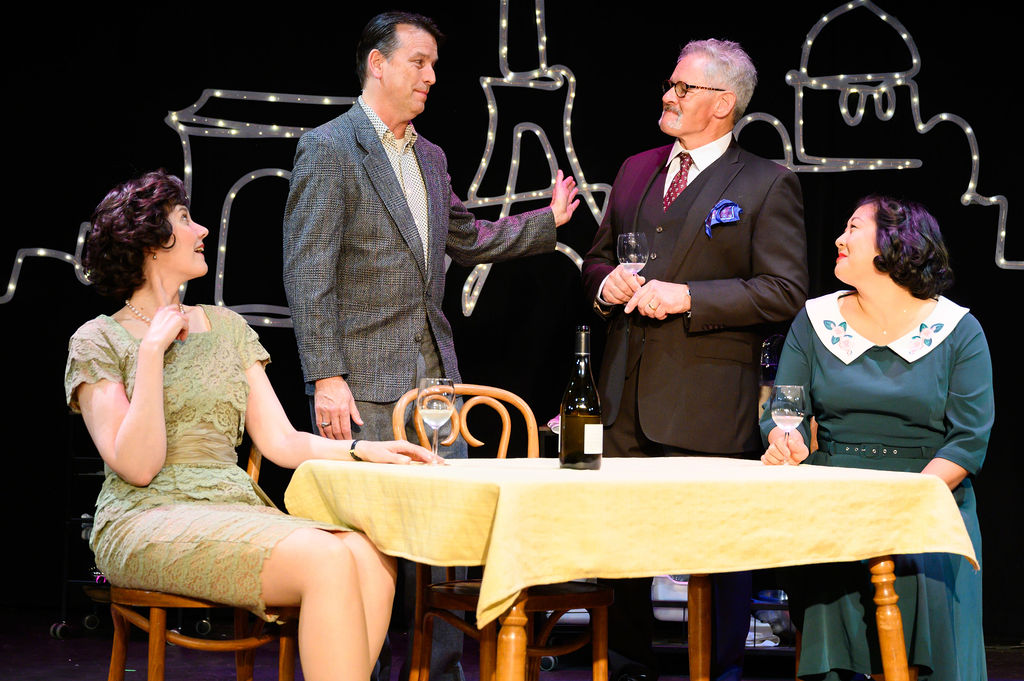
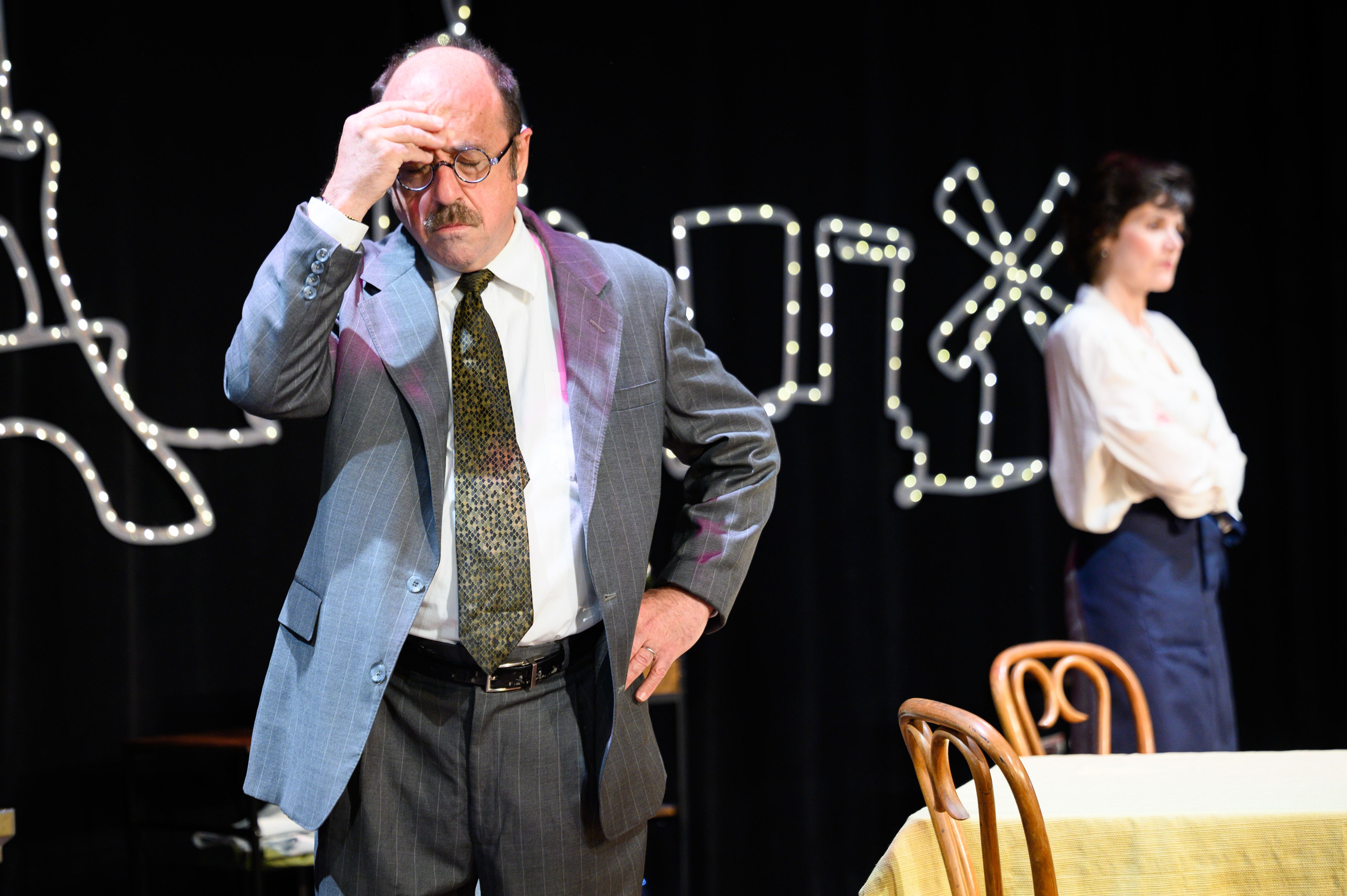
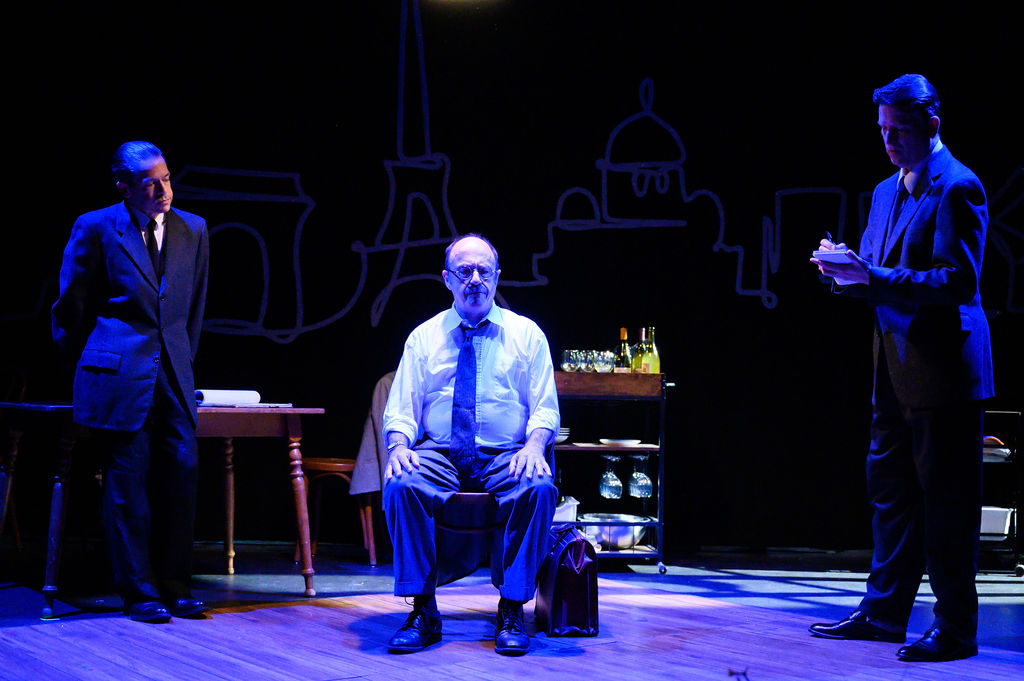
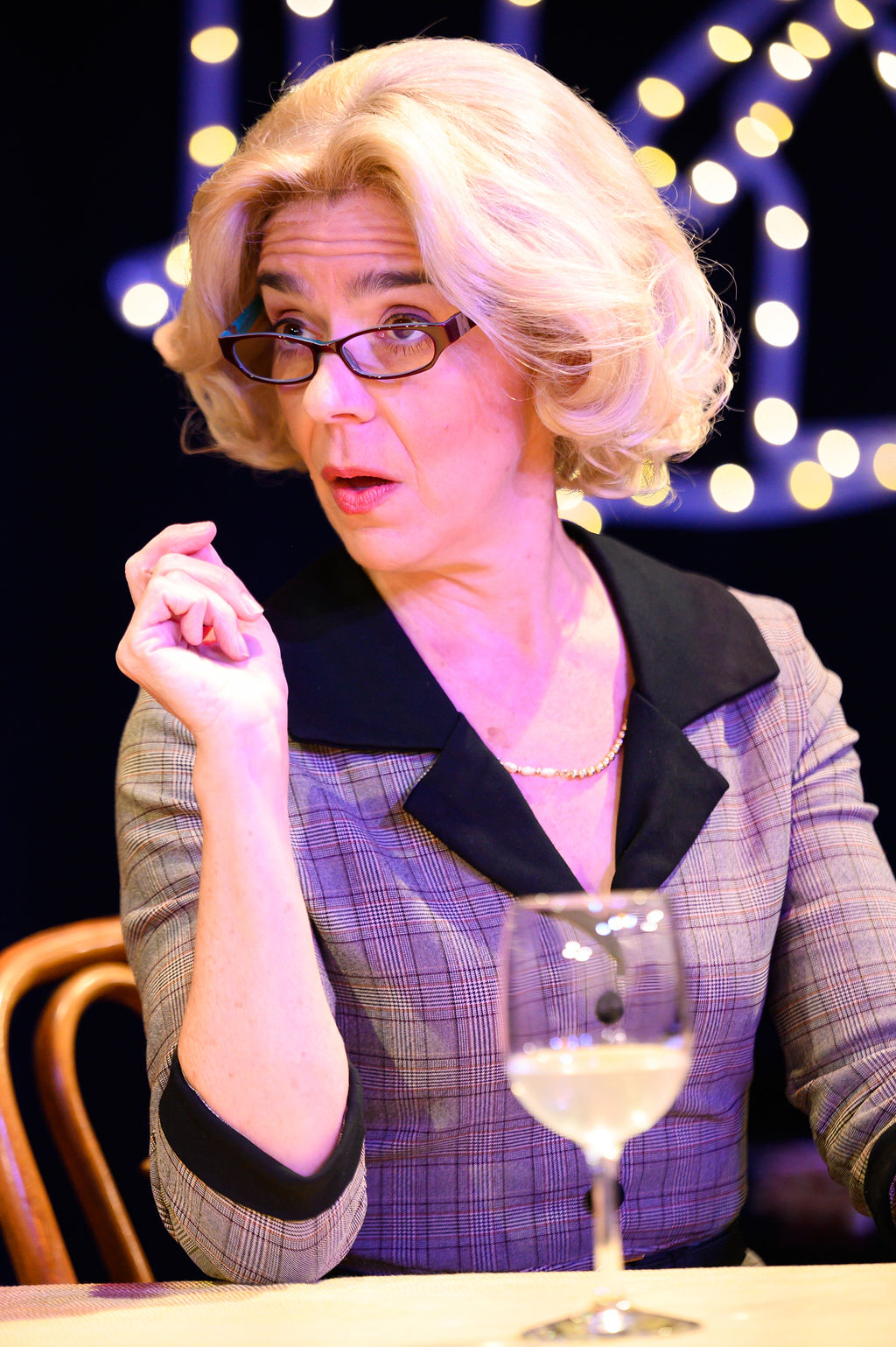
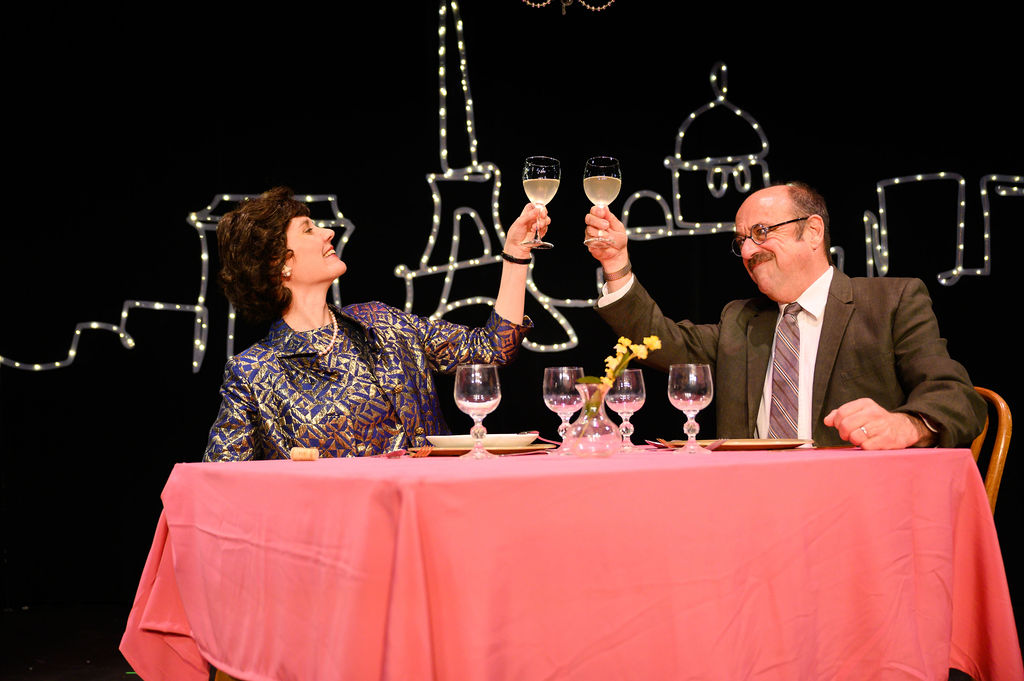

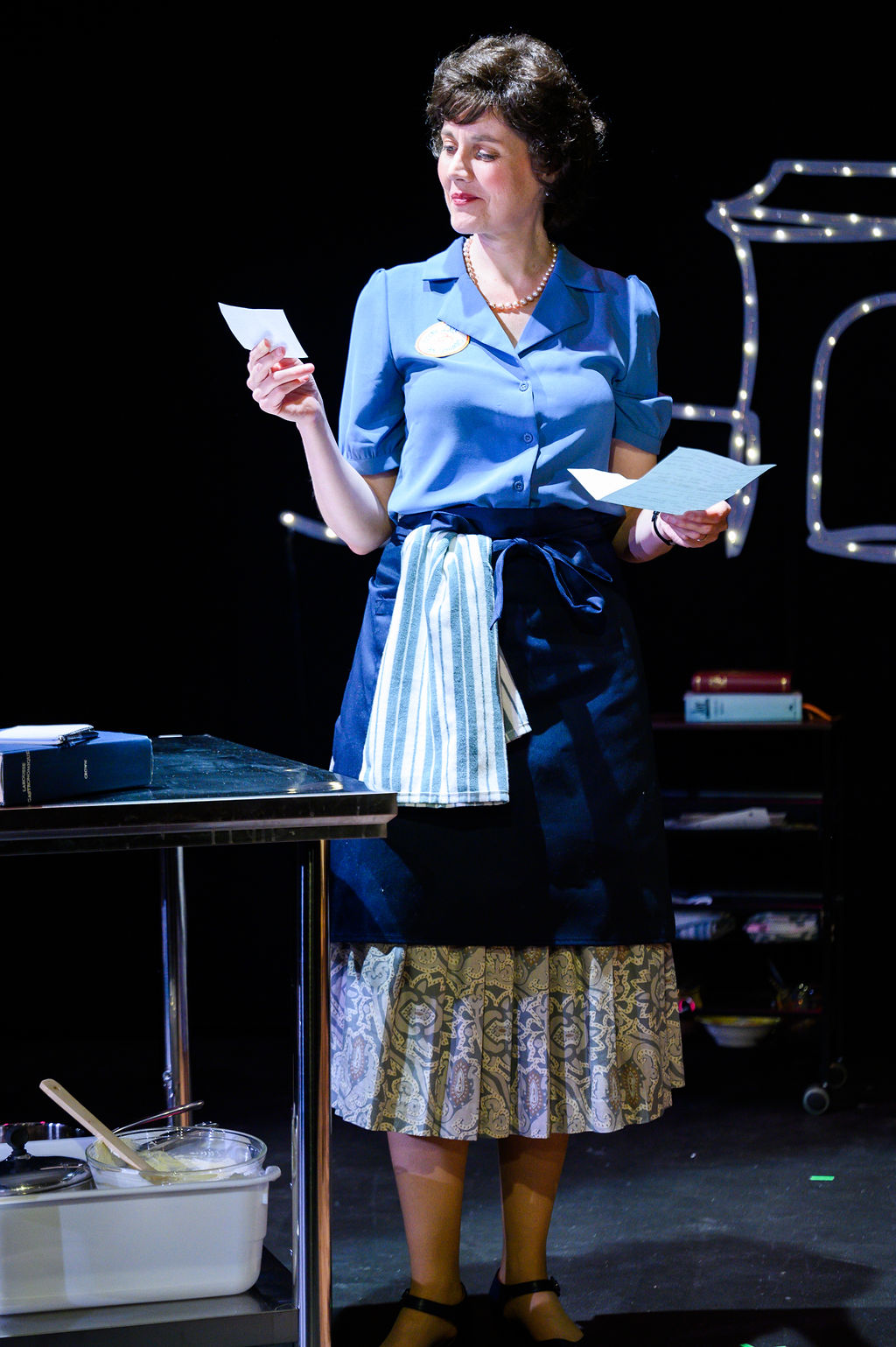
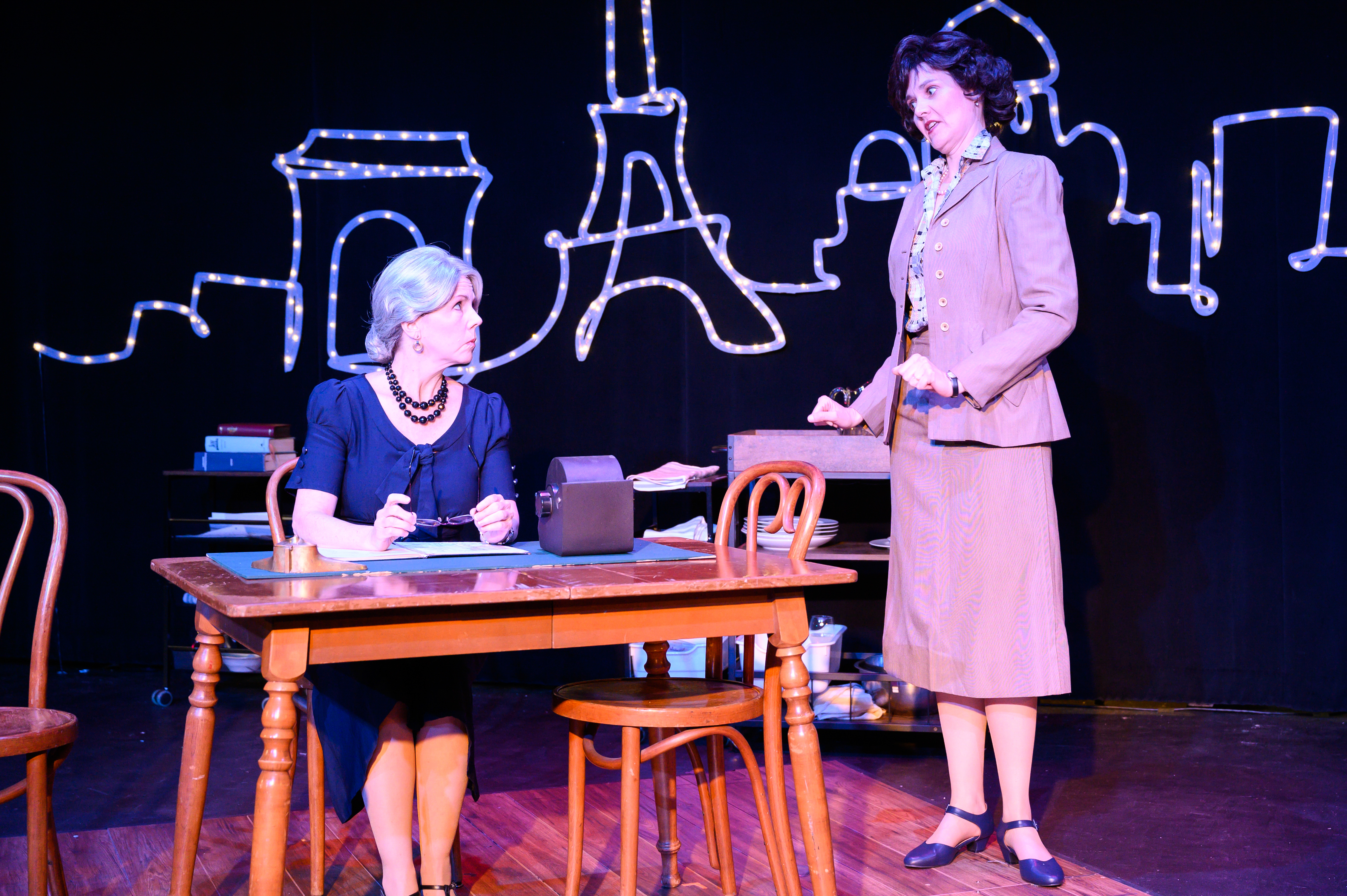
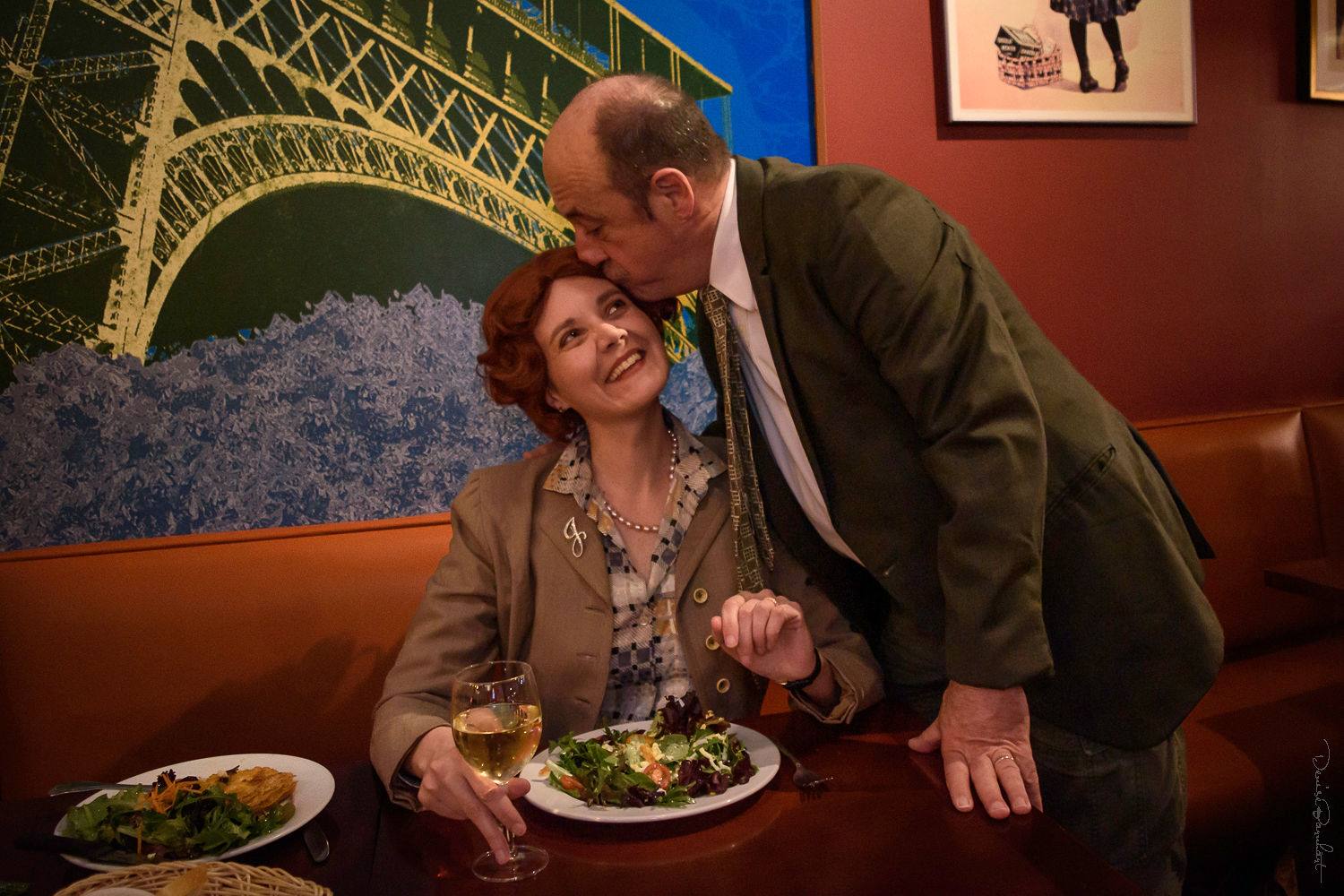
Maria Mikheyenko as Julia and Michael Sally as Paul; photo by Denise Barnhart
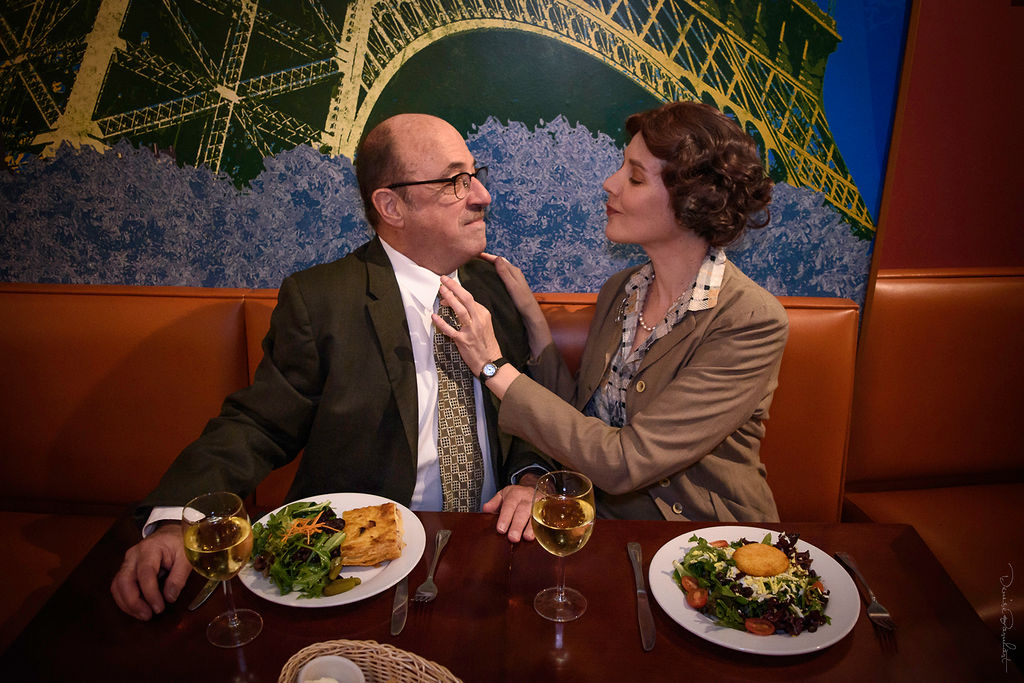
Michael Sally as Paul and Maria Mikheyenko as Julia; photo by Denise Barnhart
Photos
Articles
Contra Costa Civic Theatre Presents The Bay Area Premiere Of TO MASTER THE ART, April 21- May 21
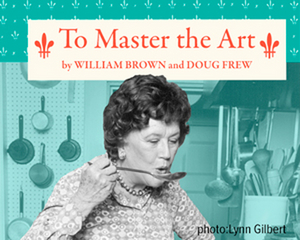
After a COVID-induced delay of nearly three years, Contra Costa Civic Theatre will bring the very first production of To Master the Art to Bay Area audiences. Originally commissioned by Timeline Theatre in Chicago, this scrumptious story about everyone's favorite French Chef plays April 21 through May 21, 2023.
Living in Paris in 1948, newlywed Julia Child was left with time on her hands, so she decided to enroll in a cooking class at the prestigious culinary academy, Le Cordon Bleu. She fell in love with the city and its cuisine, and four years later published her seminal cookbook "Mastering the Art of French Cooking", which helped to bring gourmet French living into many American homes for the first time. With wit and humor and a whole lot of butter, To Master The Art tells Julia's personal story, illuminating her journey from amateur cookbook author to international food icon.
This Bay Area premiere production is directed by Marilyn Langbehn, now in her tenth season as CCCT's Executive Artistic Director. Productions for the company include Our Town, Anton in Show Business, Broadway Inside Out, Bright Star, The Last Five Years, All the Way, Ragtime, All is Calm: The Christmas Truce of 1914, Cabaret, The Sound of Music, The Complete Works of William Shakespeare (abridged)[revised], The Mountaintop, and the world premiere of The Lost Years. Her critically-acclaimed production of August: Osage County received Best Production and Best Director nods at the inaugural Theatre Bay Area awards in 2014. She founded the Theatre's Reading Stage series in 2015 to showcase the work of women playwrights and playwrights of color. To date, the series has produced more than 20 works, including plays by Katori Hall, Theresa Rebeck, Cynthia Wands, Kimber Lee, Leah Nanako Winkler, Jiréh Breon Holder, and Inda Craig-Galván, and the widely-acclaimed world premiere of her play, Running For My Life, about the January 6th insurrection.
"One of the things we all missed during the early days of the pandemic was the ability to gather together around a table and share a meal with family and friends," said director Marilyn Langbehn. "If I never go to another Zoom cocktail party, it'll be too soon. We all tried to stay connected, but you could feel communities getting smaller. It was no surprise that people wanted to get back to eating a meal together as soon as we possibly could. In To Master the Art, Julia Child embodies the idea in the play that food - the cooking, serving, eating, and even the cleanup after - can be such a gift of love to those who share it with you. She was a genius of hospitality, completely unpretentious, deadly serious about her work and not at all serious about herself. The company is having a blast spending time with her!"
Playwright Doug Frew's most important qualification for writing this particular play is his lifelong devotion to everything Julia Child represents, a passion he shares with co-author William Brown. With his late partner Patti McKenny, he co-wrote the lyrics for William Brown's adaptation of She Stoops To Conquer (composer Andrew Hansen) at Northlight. Together they also wrote the musicals Becoming George (composer Linda Eisenstein); 90 North (composer Daniel Sticco), winner of ASCAP's Outstanding New Musical Award and inaugural production of ASCAP's "In the Works" program at the Kennedy Center; and the satirical revue Get Funny Or You're Fired at the Royal George. As a writer and creative director in corporate communications, he has created songs, sketches, videos, speeches, and entire musical comedies in praise of everything from tractors to hamburgers to all manner of pharmaceutical products. He was for several seasons a regular contributor to Garrison Keillor's A Prairie Home Companion.
Co-author William Brown is an Associate Artist at TimeLine Theatre in Chicago, where he has also directed the world premiere of Wasteland, Halcyon Days, Paragon Springs, and the Midwest premiere of Not About Nightingales. He has directed 17 plays at Writers, including Moon For The Misbegotten, Company, The Liar, and A Little Night Music. He has directed productions at Northlight, Goodman, Indiana Rep, Marriott, Drury Lane Oakbrook, Court, and Milwaukee Rep. He's directed 20 plays at American Players Theatre, including The Recruiting Officer, King Lear, A Streetcar Named Desire, Travesties, and All My Sons. Bill has been associated with Montana Shakespeare in the Parks for 40 years as both actor and director. He has also acted in more than 100 productions across the country. His adaptations include a Western version of She Stoops To Conquer with music, an 85-minute production of Hamlet for high schools, and a nine-person modern dress adaptation of The Way Of The World. Brown received Joseph Jefferson Awards for Director (The Liar) and Actor in a Principal Role (Nixon's Nixon). He received a 2010 Spirit of Diversity Award from Actors' Equity Association, and the Chicago Tribune named him Chicagoan of the Year for Theatre in 2003. His website is williambrowndirector.com.
Andrew Hansen is a composer, sound designer and an Associate Artist at TimeLine, where he has composed for To Master The Art, Rutherford And Son, Master Class, In The Next Room Or The Vibrator Play, The Normal Heart, and 33 Variations, among many others. He has worked at many theatres in Chicago, including Writers Theatre, Goodman Theatre, Northlight Theatre, Lifeline Theatre, American Players Theatre, Montana Shakespeare In The Parks, Project Runway. Regionally, he has worked with Indiana Repertory Theatre, Summer Shakespeare at Notre Dame and Montana Shakespeare in the Parks. He has received 30 Jeff Nominations and won three Jeff awards (1 Equity, 2 Non-Equity) and three After Dark Awards, including the Jeff Award for Original Incidental Music for the 2010 production of To Master The Art. A graduate of Montana State University, he holds a BA degree in Media and Theatre Art.
Our production features a host of CCCT favorites: Maria Mikheyenko (as "Julia Child") and Michael Sally (as her beloved husband "Paul Child"). Maria was last seen at CCCT as "Mother" in Ragtime; Michael last appeared as "George Wallace" in All the Way. Others in the company include Anne Yumi Kobori (as Simone Beck, co-author of "Mastering the Art of French Cooking," and Madame Dorin, owner of La Couronne, the oldest inn in France); Harrison Alter as Chef Max Bugnard, Julia's father Big John McWilliams, and Hollings, a publisher with Houghton Mifflin); Trish Tillman (as editor Avis de Voto, and Director of the Cordon Bleu Madame Brassart); Kelly Rinehart (as alleged Soviet spy Jane Foster Zlatovski, and Judith Jones, publisher at Alfred A. Knopf); Jeremy Cole (as fellow Cordon Bleu student Carolina, and C.I.A. investigator Black); and Laszlo Horner (as Gilles, fellow Cordon Bleu student Mick, and C.I.A. investigator Smith.)
To Master the Art runs for five weekends from April 21 through May 21. Tickets range from $10-$35, and are available on the theatre's website at ccct.org. All performances take place in-person at the theatre, 951 Pomona Ave (cross street Moeser) in El Cerrito. Free parking is available in the adjoining lot and on the street. COVID protocols for attending the in-person performances are updated regularly and are available on the theatre's website at www.ccct.org/safety.
Celebrating its 63rd season in 2022-23, Contra Costa Civic Theatre (CCCT) embraces the notion that theatre is a vital part of a healthy community and serves its citizens best when it provides a welcoming home for all people who value the power of storytelling. Established in 1959 by Louis and Bettianne Flynn and a group of dedicated volunteers and under the artistic direction of Marilyn Langbehn for the past ten years, CCCT is proud to provide entertainment and education to the El Cerrito and East Bay communities that help it to thrive.
Julia Child in the OSS
by Erin Merritt, Dramaturg
Julia had been civically- and service-minded before WWII, including volunteering with the American Red Cross, so it’s no surprise she would turn to service during wartime. Two inches too tall for the WACs (Women’s Army Corps), in 1942 Julia applied for work at the Office of Strategic Services (OSS), the predecessor of the CIA. Based in Washington DC, she began by doing basic, unclassified research and human resources work like most of the 4500 female staff members but quickly rose through the ranks. During this time she also began studying French, taking 3 lessons a week. Within 6 months, she was promoted to OSS’ Emergency Sea Rescue Equipment Section, where she was part of a team that developed a shark repellant out of copper acetate, her first “recipe,” as she called it. From there she was promoted to Chief of OSS Registry, working with top secret documents—she spent 1944 to the end of the war abroad posted to Ceylon (Sri Lanka) and later, Kunming China. She would have known every incoming and outgoing message that passed throughout her office, as her Registry was serving all the intelligence branches; in Ceylon she worked with highly classified papers dealing with the invasion of the Malay Peninsula, and left China having received the Emblem of Meritorious Civilian Service, the highest award granted to civilians by U.S. Army Commanders. She left the OSS at the end of the war having learned French and met her future husband, Paul Child, who remained with the OSS and whom she married in 1946. Paul was assigned with the U.S. Information Agency in France in 1948, and the rest is history.
References
https://www.history.com/news/julia-child-oss-spy-wwii-shark-repellent
https://www.cia.gov/stories/story/julia-child-cooking-up-spy-ops-for-oss/
How Did These People Get to France, Anyway?
From Quora
Jay Bazzinotti
In the early part of the 20th century most people traveling to Europe traveled by ocean liner. The all-iron steamship was invented by Isambard Brunelle in 1837 with the SS Great Western but by 1900 the ocean liner was a common thing. Early liners had masts and sails as well as steam engines, and the Great Western was a paddle wheeler. However, the invention of the propeller by the Swedish-American engineer John Ericsson changed sea travel. While sailing ships could take weeks, ocean liners at the turn of the century could make the trip in a week or less. Ocean liners from England, Italy and Germany competed on speed and luxury. They also made enormous amounts of money transporting the mail and steerage passengers who were jammed into ships below decks. In 1907 second class passage on a 2nd rate liner was about 28 dollars, about 800 dollars today.
Passenger liners competed for the Blue Riband, a prize given to the ship that sailed across the Atlantic the fastest. The prize changed hand from year to year. The English liner “Mauretania” was the longest holder of the Blue Riband, winning it every year from 1909 to 1929. This was a remarkable achievement. The entire White Star Line’s three sister ships, the Olympic, the Titanic and the Brittanic were built to contend for the Blue Riband while providing incredible luxury for the First Class passengers, who could expect to pay $4350 for a suite, the equivalent of $100,000 dollars today. However, a simpler room in First Class was only about 5000 dollars today.
During World War 1 transatlantic passage suffered. There was no other way to cross the ocean and so if you had to go you were taking your life in your hands. Many ocean liners like the “Lusitania” were sunk; some were seized by governments and turned into troop ships. Some ended up like the “Brittanic” and were used as hospital ships. The “Brittanic” sank in the Mediterranean after hitting a mine. Some, like the luxury liner “Wilhelm de Grosse” were converted into warships. The “Wilhelm” was made into a light cruiser and sunk in combat with the English. Some liners, like the “Carpathia” which rescued survivors from the Titanic, were sunk by U-boats.
After the war transatlantic passage exploded. In 1926, 130,000 First Class passengers alone made the passage from the US to Europe or vice versa. It was the demand for fast service and high prices of delivering the mail that led to the German airships “Graf Zeppelin” and “Hindenburg” to achieve transatlantic service in 1928. These ships transformed travel, making a total of nearly 300 transatlantic (and over 1000 total) flights, both flying over a million miles during 10 years of service and transporting nearly 30000 passengers, 24 at a time in the gondola beneath the gasbag. The zeppelin reduced travel time from a week on the fastest liner to just a couple of days. A ticket cost the equivalent of about 11,000 dollars today. The “Hindenburg” was destroyed in New Jersey in 1937 and the “Graf Zeppelin” was dismantled for the metal to make fighters in 1940. In 1939 Lufthansa became the first to attempt passenger service with the 4-engine Focke-Wulf 200 Condor but the war ended anything beyond test flights and the Condor went on to become a maritime bomber.
In 1939 Pan Am began its Boeing 314 Clipper service from New Jersey to Lisbon, Spain. A ticket cost about 1000 dollars in today’s money and the trip took a couple of days because the plane had to stop to refuel in Ireland. Passage was very luxurious and many amenities were provided on board the roomy planes, very much like Pullman service. The planes could carry 34 passengers and were no faster than the zeppelins but they were more comfortable and much cheaper - the zeppelins were not heated.
In 1946 Pan Am introduced regular DC-4 service from New York to Southampton, England. It took almost 18 hours to make the flight but the writing was on the wall - the death of the ocean liner was assured. In 1952 the SS United States was the last liner to win the Blue Riband. Although regular cruise ship passage continued on til the late 1960s, it became unprofitable. Since then, the Blue Riband has been passed between crews of ocean racing vessels, not passenger ships.
Here’s a promo for Cunard Liners (the Paris part starts at 11:47)—see how travel was marketed then plus how people dressed:
https://www.youtube.com/watch?v=OyQCkF3riKY
Check out this Air France brochure from the time, which begins “He has enough success” claims “time isn’t money—time is life,” and argues that travel is not just for the elite, that we have worked hard enough and deserve to relax and us enjoy ourselves
https://www.ebay.com/itm/265759016450
And some American ones:
https://www.amazon.com/France-All-Europe-American-Airlines/dp/B00BSGFA00?th=1
https://www.ebay.com/itm/371692685433









